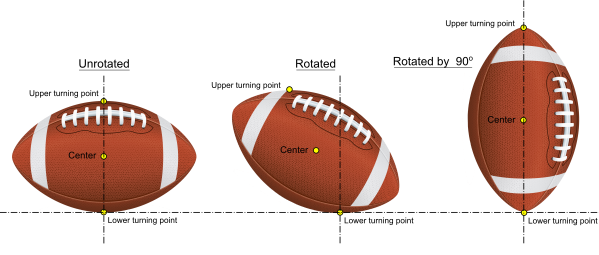
Knowing that by rotating the Earth ellipses the geometry lines begin to match the surveyed architecture, the faces of the pyramid can be reconsidered, and the interactive drawing shows the principal ellipse rotated by a specific angle, and the geometric faces lines and base line of the building are highlighted.
When you form the external stonework of the pyramid from a rotated ellipse in this way, something very interesting happens in the geometry that is not immediately obvious.
On the very first page of this work the positioning of the primary ellipse was emphasized as being that the lower turning point of the ellipse was at the base line's center point. Maintaining this definition when the ellipse is rotated causes its upper turning point to become offset from the Y axis to the south. The easiest way to understand this is to picture a football (which is also largely elliptical) undergoing the same rotation :

In the illustration you can see that with no rotation, the upper and lower turning points are vertically above each other, with a negative rotation angle applied to the football the upper turning point becomes offset to the left, and with a 90° rotation the turning points return to being vertically in line with each other.
If you consider this system carefully, and consider how the north face of the pyramid is formed from a line which connects the end of the base to the upper turning point of the principal ellipse, then there must be a specific angle of rotation for the ellipse which minimises the angle of the north face.
For the Earth's polar cross section this rotation angle is 34.1965° and it is to this angle that the axial tilt has been set to in the interactive drawing.
The object information panels show the asymmetric geometric angles of the two face lines as a result of this rotation and if you zoom in on the pyramid's apex (click and hold) you can see that the asymmetric geometric lines now match the asymmetric surveyed north and south faces of the building.
The triangular construction on the drawing, with the north face angle minimised, forms the external geometry of the pyramid that is literally set in stone. It is a fixed reference container inside of which all of the pyramid's internal geometric architecture is set.
The face angles determined from this geometry are the correct face angles of the building that you can visit today in Cairo, and the error margin of these angular values is close to zero, as they are determined by the WGS84 reference ellipsoid's defining parameters, which are known to a high degree of accuracy.
Because this external architecture is static, then the rotated ellipse from which it is formed must also be static and ever present in the geometry. This static ellipse is essential to a full understanding of the pyramid and will be named as:
Every time that static architecture is encountered in the design of the Great Pyramid, it will be formed from this static reference ellipse.